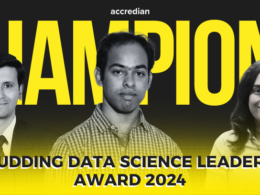Introducing Ashutosh Kumar Pandey, a graduate in Electronics and Communication Engineering, who initially pursued opportunities in engineering services and government departments. However, during his journey, he noticed the rapid evolution and rise of Data Science and AI technologies, which instantly captured his interest.
Ashutosh’s background in engineering has always had an attraction towards such technologies, leading him to explore the world of Data Science further.
In this Accredian Spotlight blog, we delve deeper into Ashutosh’s journey and how Accredian played a crucial role in helping him achieve his Data Science aspirations.
Question 1: Which program and batch are you part of at Accredian and tell us more about your current work profile.
Ashutosh: I am a part of Accredian’s Global Certificate in Data Science program from the August 2022 Cohort.
Question 2: Walk us through your career journey & what got you interested in Data Science & Machine Learning.
Ashutosh: After completing my school academics, I opted for Engineering in Electronics and Communication. After graduating, I simultaneously pursued opportunities in engineering services and government departments, as well as attempted to secure a position in PSC services.
While on this journey, I also observed the rise and evolution of data science and AI technologies, which really excited me. Perhaps this is due to my background in engineering, which has always had an attraction towards such technologies.
Question 3: What all tools and packages in Data Science & Machine Learning have you mastered in your Data Science & AI program at Accredian so far?
Ashutosh: Accredian has extensively helped me master a number of tools and packages used for DSM through their online classes and study materials. Some of the tools which I would like to mention are NumPy, an open-source Python library for working with numerical data.
Another tool is Pandas, a fast, powerful, and easy-to-use open-source tool for data analysis and manipulation. Additionally, I have also learned to use Matplotlib, a cross-platform data visualization and graphical plotting library for Python.
Question 4: What are some of initial challenges when you got started on your Data Science journey and how did you overcome it?
Ashutosh: In the initial phase of our data science journey, I faced some challenges, such as not having any coding knowledge in Python and not having a good command of statistics, as it was not a part of my Engineering Academy curriculum.
However, as I progressed on my Data Science journey, I found that these challenges were not as big as I had imagined them to be. One simply needs to learn and understand these concepts, which are relatively simple in nature.
Moreover, Python is a simple language that one can easily master within a few days. Accredian provides all the necessary resources and assistance to make understanding these concepts even easier.
Question 5: What is the goal of Data Science?
Ashutosh: The objective of Data Science is to explore and analyze large datasets from various sources in order to leverage them and reach conclusions that optimize business processes and support decision-making.
The main goal of data science is to discover patterns and trends in data, gain insights, create forecasting algorithms and data models, and improve the quality of our products and offerings by utilizing machine learning techniques.
Question 6: In your view, how has Data Science evolved in last few years?
Ashutosh: Data Science has undergone significant evolution in the last few years. The term ‘data science’ was coined in the early 1960s to describe a new profession that would support the understanding and interpretation of large amounts of data. However, at that time, there were very limited ways to collect data, and these methods generated a relatively small amount of data.
In recent years, due to the evolution of technology in almost every aspect of life, there has been a significant increase in the generation of large amounts of data. This huge data has now become the raw material for data science, which was not available in ample amounts in the field’s initial days.
As the importance of data has increased, organizations interested in finding patterns and making better business decisions have seen a dramatic growth in demand for data scientists.
After Machine Learning and AI officially entered the realm of data science, these technologies have driven innovation in the field, from personalized helping to entertainment to self-driving cars.
Currently, data scientists are exploring ways to use machine learning to produce more intelligent and autonomous AI.
Question 7: What are the current trends in Data Science that you are most excited about?
Ashutosh: There are decades where nothing happens, and then there are weeks where decades happen. Now, almost the same thing is happening in the data science field. Many hot and trending topics are emerging, which really excite me.
One of them is Artificial Intelligence, which has been penetrating day-to-day life of individuals and companies, creating a buzz in the industry. Another trend that excites me is the Internet of Things, which is witnessing a phenomenal rise and is expected to have an even greater impact on business activities.
Natural language processing (NLP) is another trend that excites me as it enables computer programs to understand human language as it is spoken and written, which will revolutionize conventional analytics for larger scales.
Additionally, Robotic process automation, which involves using cutting-edge software tech to build, deploy and manage robots to mimic human actions, will also grow in power in the near future.
Lastly, Augmented and virtual reality, which help to enhance interaction between humans and machines, are fields that are expected to grow and dominate the tech industry in the coming years.
Question 8: What is your advice to anyone wanting to start a career in Data Science?
Ashutosh: My advice would be, it’s not too late to know these quick tips to boost your chances in the data science industry.
First, it is important to clear your basics and know the fundamental programs. Strengthen your communication skills. Build a strong resume with internships and grow your network. Then, choose the right role and follow the right resources.
There are various roles in the data science industry, such as a data visualization expert, a machine learning expert, a data scientist, an engineer, etc. Depending on your background and work experience, getting into one role could be easier than others, so choose the right role wisely. Next, choose the right tool and language.
It is important to gain experience in whichever topic you pursue. Beginners often ask which tool and language they should stick to. My suggestion is to master one language and one tool, which should be more than enough.
Focus on practical applications rather than just theory. During courses and training, focus on the practical applications of what you are learning. This will not only help you understand the concept better, but also give you a deeper sense of how it is applied in reality.
We hope you enjoyed reading this interview. Check out the Accredian Spotlight for more interesting student stories like this.





